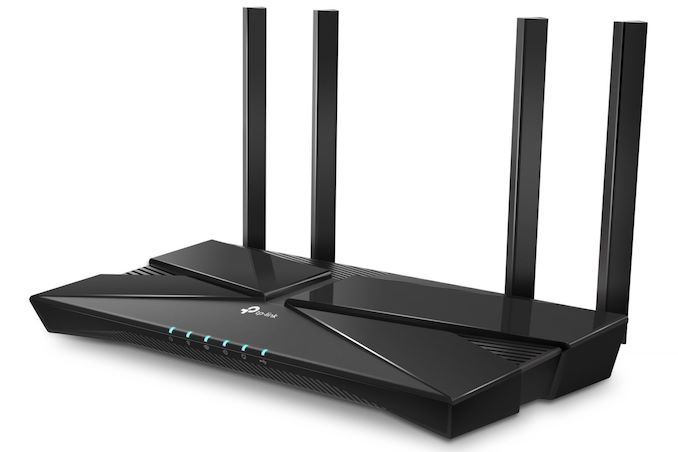AT 101: Wi-Fi 6 And Why You Want It
by Brett Howse on February 12, 2020 8:00 AM EST
Over the last generation of computing, there has been an explosion of devices that no longer have or need the capability of connecting to a hard-wired Ethernet connection, and that trend shows no intention of slowing down. When Personal Computers first started to utilize wireless Network Interface Cards (NICs) they would almost always be the sole device on the network. Fast forward to today, and practically every home has multiple devices, if not dozens, where the devices communicate using radio waves, either over a cellular connection, or over a home wireless network featuring Wi-Fi.
In the PC space, which is the focus of this article, cellular connectivity certainly exists, but almost exclusively in niche roles. While there are advantages to offering directly cellular connection on the PC, the extra recurring cost, especially in North America, means that most laptop owners will use Wi-Fi for network communication.
The term Wi-Fi is something that is omnipresent today, but if based on the Wi-Fi Alliance and adoption of IEEE 802.11 standards for local area networking over wireless. Although the Wi-Fi Alliance has recently renamed their standards, Wi-Fi has in the past been named directly based on the 802.11 standards as follows:
| Wi-Fi Names and Performance | ||||||
| Naming | Peak Performance | |||||
| Branding | IEEE Standard |
1x1 Configuration |
2x2 Configuration |
3x3 Configuration |
||
| Wi-Fi 4 Channel Width 20/40 MHz |
802.11n | 150 Mbps | 300 Mbps | 450 Mbps | ||
| Wi-Fi 5 Channel Width 20/40/80 MHz Optional 160 MHz |
802.11ac | 433 Mbps 867 Mbps |
867 Mbps 1.69 Gbps |
1.27 Gbps 2.54 Gbps |
||
| Wi-Fi 6 Channel Width 20/40/80/160 MHz |
802.11ax | 1201 Mbps | 2.4Gbps | 3.6 Gbps | ||
In an effort to simplify branding, the latest three standards of 802.11n, 802.11ac, and 802.11ax have been rebranded to Wi-Fi 4, Wi-Fi 5, and Wi-Fi 6, respectively. In the long term, the new branding should be much easier for most people to grasp, since larger means newer, although we’ve already got some confusion with Wi-Fi 6E – the 6GHz band addition for Wi-Fi 6 – so we shall see how that goes.
 One of the many Wi-Fi 6 routers announced at CES 2019 - TPLink AX1800
One of the many Wi-Fi 6 routers announced at CES 2019 - TPLink AX1800
Today, most homes should have at least Wi-Fi 4, or what used to be 802.11n. After all, this standard came along in 2009. Many will even have Wi-Fi 5, or 802.11ac, which offers some speed upgrades and a few optional extra features to help with scaling. Wi-Fi 6, or 802.11ax, is a very new standard, and until the end of 2019 there were not even that many devices which could connect over it. So, what is the point of this new standard, and do you really need to upgrade your home network?
This article intends to help answer those questions, as well as show how we at AnandTech are transitioning to Wi-Fi 6 for future reviews.











149 Comments
View All Comments
levizx - Wednesday, February 12, 2020 - link
Because affordable 1Gbps connection isn't a thing for even 90% of high-end buyers yet, let alone > 1GbpsMakaveli - Wednesday, February 12, 2020 - link
If you are in the US then yes internet is terrible in america.Fortunately for me I live in Canada and on a 1Gbps Fiber connection.
triphoppingman - Wednesday, February 12, 2020 - link
This article from 2016 actually says Canadia is barely faster than Mexico.https://www.forbes.com/sites/kevinmurnane/2016/09/...
Wikipedia agrees:
https://en.wikipedia.org/wiki/List_of_countries_by...
Makaveli - Wednesday, February 12, 2020 - link
lol you believe a Wiki Article then.Unless you live in chattanooga or have access to AT&T fiber or google fiber or fios you are pretty much stuck with Cable/dsl for options which are data capped.
Most of our major ISP's in Canada got rid of data caps years ago.
Trust me when I tell you Canadian internet is generally better than what you can get in the US.
imaheadcase - Wednesday, February 12, 2020 - link
Thats pretty subjective though considering Canada population is mostly in one area vs the US.Makaveli - Wednesday, February 12, 2020 - link
Subjective or not its the truth.not trying to get in a population density argument like the Europeans that come in trying to do the same thing lol.
nathanddrews - Wednesday, February 12, 2020 - link
That's the problem with relying on aggregated national data rather than per-market pricing. I can get 1Gbps fiber for $130/mo in my suburb, but 10 miles north of me the only option is dial-up (cheap/slow) or satellite (expensive/slow). 10 miles west of me, there's a smaller fiber ISP offering 2.5Gbps for $150/mo that I can't get. It's not rocket science, just infrastructure and economics.Flipper34 - Wednesday, February 12, 2020 - link
Even out here in the rural midwest we have fiber to the home available. It isn't inexpensive for the higher speeds, but it is available. Our connection was upgraded to fiber at no cost, but we are on a low speed cheap plan! :)Ratman6161 - Wednesday, February 12, 2020 - link
where in the midwest are you? That is certainly not true in Minnesota. I'm about 40 miles from Minneapolis and 200 Mbps is the best I can get. For family about 10 miles out of St Cloud, 40 is the best they can get. further out it goes down from there. Likewise with cellular. the carriers are hyping 5g when there are vast areas in the northern half of MN and WI that cant even get reliable 4G and when the can its only one carrier to choose from.pjcamp - Wednesday, February 12, 2020 - link
For anything not controversial, Wikipedia articles are pretty accurate. I'm a physicist and I'm thoroughly impressed by the physics articles.